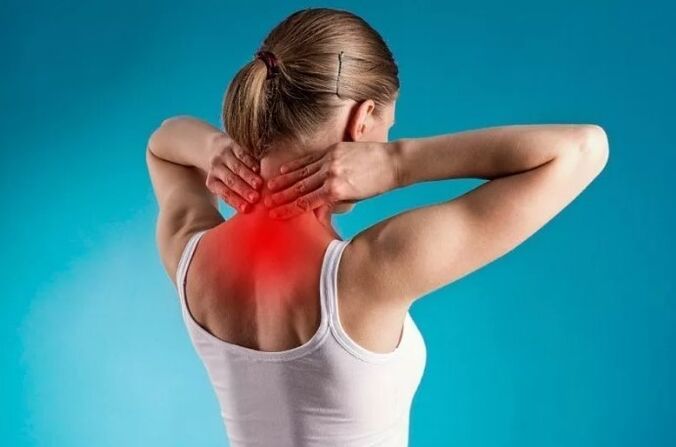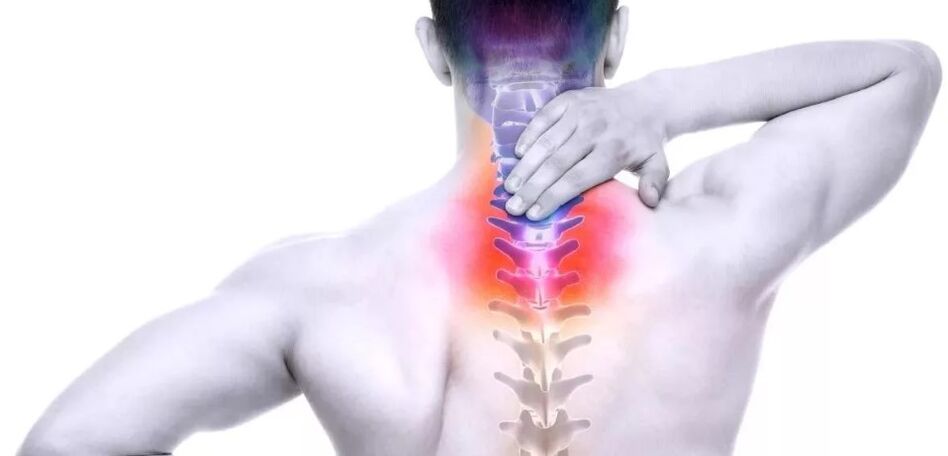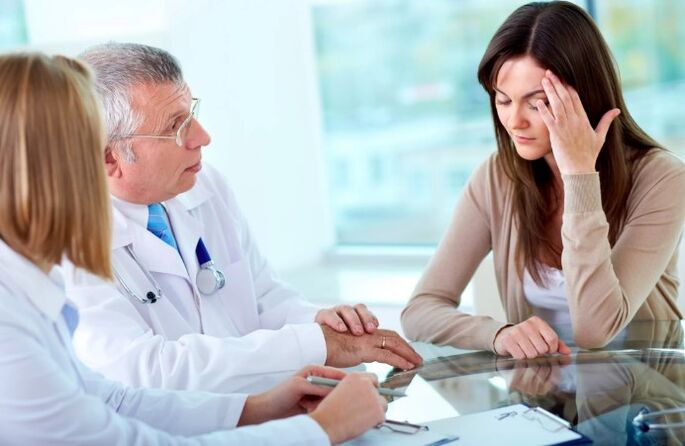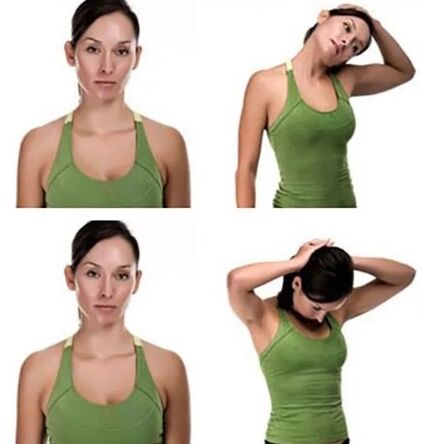The cervical osteocondrosis is the progressive dystrophic and deignerative lesion of the intervertebral discs in the area of 1-7 vertebrae belonging to the cervical region.
Due to the cervical osteocondrosis, the deformation, the exhaustion and therefore the damage to the vertebral bodies. This interrupts the intake of normal blood and the nervous conductivity in the neck and in those areas innervated by the roots of the nerves of the cervical nerves.
Cervical osteochondrosis can be isolated or combined with osteochondrosis of other departments: lumbar and sacral.
Reasons

The causes of the dystrophic and degenerative changes in the intervertebral records have not yet been studied. The hypothesis that osteochondosis is a senile confirmation phenomenon. It is also found in children and adolescents.
Numerous factors that predispose to the development of osteocondrosis are distinguished. These include:
- Secomer and sedentary lifestyle,
- Sitting types of work with a static load on the neck,
- Overweight and insufficient physical development,
- Dysplastic processes of the connective tissue,
- Violation of blood circulation in the neck,
- neck lesions,
- Scoliosis, defects of posture, cushions and discomfort mattresses,
- Hereditary predisposition, metabolic defects.
Symptoms of cervical osteochondosis
The cervical column, due to the characteristics of the skeleton, simplicity, as well as due to the large size of the head, is particularly vulnerable to the development of osteochondosis, the vertebrae in it are the smallest compared to other parts of the spine and the muscle frame is not very pronounced.
The most characteristic symptom that patients complain about: pain in the cervical region. Depending on the damage area, the pain can be located
- in the collar and shoulder;
- throughout the cervical column;
- On the front surface of the chest.
The pain for cervical osteochondosis is due to the characteristics of the cervical region.
The first signs of cervical osteochondosis are insignificant and slightly specific:
- Neck pain in the evening,
- feeling of heaviness in the head, headache in the occipital area,
- a feeling of numbness or tingling in the back and hands,
- Crystals in the neck when turning your head, clicking on the vertebrae.

Leader symptoms:
Vegetative-destruction
- Pain quite serious in the neck and, above all, in the area just under the back of the head;
- Pain occurs after a long stay in a position (for example after sleep);
- The neck muscles are constantly tense;
- There are difficulties with the abandonment of the hand on the side;
- On the affected side, the fingers are bound in the movements.
Since the vertebral arteries are compressed, neurological manifestations are observed: headache, nausea, fainting.
Spinal symptom
The pain is located behind the sternum on the left.
This type of pain should be distinguished from pain as in the angine pectis (with Angina pectis, nitroglycerin is relieved, with osteochondrosis - no).
With a gradual violation of the structure of the intervertebral discs, their compression (compression) occurs and a violation of the roots of the nerves occurs, as well as narrowing or violation of arteries and veins, which take place in the area of vertebral bodies.
This leads to the formation of special - root and ischemic syndromes.
- The defeat of the roots of the first cervical vertebra (C1): violations influence the back of the head, reducing the sensitivity to the skin;
- The C2 lesion gives pain to the crown of the crown and rear of the head;
- The lesion of C3 gives neck pain on the side of the violation, a decrease in sensitivity in the language and muscles of the secondary language, in some cases with impairment of language and loss of control over the language;
- The defeat of C4 and C5 gives pain to the shoulder and clavicle, a decrease in the tone of the muscles of the head and neck, the sobs, the respiratory disorders and the pain in the heart;
- The defeat C6 is often, giving pain from the neck to the scapula, the forearm, the thumbs, the sensitivity to the skin can suffer:
- The C7 defeat provides similar symptoms with neck pain, rear of the shoulder, up to the back of the hand, violation of the strength of the hands and a decrease in reflections.
Blood circulation disorders due to the compression of the vessels in the area of the cervical vertebrae give headache to the emicranium, serious dizziness, visual impairment and ears in the ears, trembling flies in front of the eyes, disorders of autonomous functions.

There may be manifestations of cardiac syndrome with compressive heart pain, lack of air and heartbeat, rhythmic disorders.
Complications
The serious complications of cervical osteochondosis are
- Professor of intervertebral discs with the formation of an hernia (protrusion);
- Breakage of the intervertebral disc with violation of nerves and blood vessels, compression of the spinal cord is possible, which can lead to death;
- There may also be radicolopathies (roots lesions), the formation of osteophytes (peaks on the vertebrae) with a manifestation of paresis and paralysis.
Diagnostics
In the presence of the aforementioned complaints, an appeal to the orthopedic doctor or neurologist is necessary.
First of all, the doctor will evaluate mobility and pain in the neck, sensitivity and other functions. Therefore, the radiography of the cervical column in different projections will be required, if necessary, computerized tomography or magnetic resonance scan with suspicion of hernia.
In case of circulatory disorders, reoenencephalography and fund exam will be needed.
Treatment of cervical osteochondosis
Today there are both traditional and non -traditional methods for the treatment of osteocondrosis in the cervical column.
Conservative methods are mainly used:
- Symptomatic therapy with analgesics to relieve pain syndrome
- Receiving of non-ste-stained standard anti-inflammatory drugs to relieve inflammation and edema of tissues
- To eliminate muscle cramps, antispasmodic and drugs are used to improve blood circulation.

In the treatment of cervical osteochdrosis, substances are used that restore the structure of the intervertebral discs - chondroprotectors.
The course of group B vitamin therapy is shown, external products for therapy are applicable: gels and ointments, creams with anti -inflammatory and analgesic components. It shows stimulants of the regeneration of intervertebral discs.
General and general massage, acupuncture, physiotion, physiotherapy and gymnastics and gymnastics help in the treatment of osteochondosis. The osteopathy method has proven well - a slight effect on the "blocked" areas of muscles and vertebrae.
In the treatment of cervical osteocondrosis, the use of a special collar (Shanta collar) is recommended.
The complications of cervical osteochondosis with hernias that violate sensitivity and blood circulation can be treated promptly.
The duration of the treatment depends on the negligence of the condition, since osteochondrosis is a progressive chronic disease. The treatment can be long and the preventive courses are performed for life.
Proper nutrition will help relieve the condition for osteochondrosis.
Exercises for the treatment of cervical osteochondosis:
- Auto-Ejection: In a position with a straight back, you need to lower your shoulders as low as possible, while the neck must be pulled up. It is necessary to make at least 10 approaches at least 3 times a day.
- Self -Massage: grace the neck with a towel, taking it at the ends and pulling it alternately, spreading the muscles of the neck. In this case, it is necessary to ensure that the towel does not slide along the neck.
- Gymnastics are shown for the cervical region for osteochondrosis: folding of the neck, as well as curves and tilting of the head. At a time, 5-7 inclinations are made in each direction. This exercise is very useful for performing after the car -masage of the cervical column.
Prevention
The base of the health of the cervical column is a strong and healthy back, physical activity, a comfortable bed with anatomical cushions and mattress, adequate posture and proper nutrition.
It is worth avoiding neck lesions and weight lifting. It is necessary to combine prolonged sitting with rest periods and heat.
























